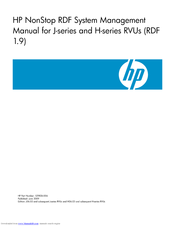User Manuals: HP NonStop RDF Data Replication Software
Manuals and User Guides for HP NonStop RDF Data Replication Software. We have 1 HP NonStop RDF Data Replication Software manual available for free PDF download: Management Manual
Hp NonStop RDF Management Manual (478 pages)
for J-series and H-series RVUs
Table of Contents
-
-
RDF States24
-
-
-
Features35
-
-
-
-
EMS Support55
-
SMF Support55
-
-
-
-
-
-
Utility Commands106
-
-
Running RDFSCAN109
-
-
RDF States113
-
Process Priority117
-
Purgetime117
-
Retaincount117
-
Updaterdelay117
-
Updateropen117
-
Asap120
-
-
-
-
-
System Failures126
-
Receiver Failure127
-
Updater Failure127
-
Purger Failure128
-
RDFNET Failure128
-
Stopping RDF132
-
Restarting RDF136
-
-
Takeover Failure143
-
-
-
-
Catalog Changes160
-
DDL Operations160
-
Table Purges163
-
-
-
-
Overview167
-
-
-
-
Overview176
-
-
Relative Tables181
-
-
-
Extractor Phases183
-
Phase 1, Part 1183
-
Phase 1, Part 2183
-
Phase 1, Part 3183
-
Phase 2184
-
-
Updater Phase 2184
-
-
-
Updater Messages184
-
-
-
Usage Guidelines188
-
-
Output Displayed190
-
Examples190
-
-
-
Disk File Names191
-
RDFCOM Commands192
-
Add193
-
Where Issued193
-
Examples194
-
Usage Guidelines194
-
Alter195
-
Examples196
-
Usage Guidelines196
-
Where Issued196
-
-
Copyaudit197
-
Usage Guidelines197
-
Where Issued197
-
Example199
-
Delete199
-
Where Issued199
-
Examples200
-
Usage Guidelines200
-
-
Exit201
-
Example201
-
Usage Guidelines201
-
Where Issued201
-
Examples202
-
Usage Guidelines202
-
Where Issued202
-
-
Help203
-
Where Issued203
-
Examples204
-
Usage Guidelines204
-
History205
-
Examples205
-
Where Issued205
-
Info206
-
Usage Guidelines207
-
Where Issued207
-
Examples208
-
INFO * Command208
-
Output Displayed208
-
INFO RDF Command210
-
Initialize Rdf212
-
Usage Guidelines215
-
Where Issued215
-
Examples217
-
Obey217
-
Where Issued217
-
Example218
-
Open218
-
Usage Guidelines218
-
Where Issued218
-
Examples219
-
Out219
-
Examples220
-
Reset220
-
Usage Guidelines220
-
Where Issued220
-
Usage Guidelines221
-
Where Issued221
-
Examples222
-
Set Extractor222
-
Usage Guidelines223
-
Where Issued223
-
-
Examples223
-
-
Set Imagetrail224
-
Usage Guidelines224
-
-
Set Monitor224
-
Where Issued225
-
Usage Guidelines225
-
Example225
-
-
Set Network225
-
Where Issued226
-
Usage Guidelines226
-
Example226
-
-
Set Purger226
-
Where Issued228
-
Usage Guidelines228
-
Example228
-
-
Set Rdf228
-
Where Issued231
-
Usage Guidelines231
-
-
Set Rdfnet231
-
Where Issued232
-
Usage Guidelines232
-
Example232
-
-
Set Receiver232
-
Where Issued234
-
Usage Guidelines234
-
Examples234
-
-
Set Trigger235
-
Where Issued235
-
Usage Guidelines236
-
Example236
-
-
Set Volume236
-
Where Issued238
-
Usage Guidelines238
-
Examples239
-
-
Show239
-
Where Issued240
-
Usage Guidelines240
-
Examples240
-
Output Displayed240
-
SHOW RDF Command240
-
Start Rdf242
-
Usage Guidelines243
-
Where Issued243
-
Example244
-
Examples244
-
Start Update244
-
Status244
-
Usage Guidelines244
-
Where Issued244
-
Usage Guidelines245
-
Where Issued245
-
Name247
-
RDF Process247
-
RTD Time247
-
Pri248
-
Cpus249
-
Error249
-
Special Messages249
-
Examples250
-
Stop Rdf250
-
Where Issued250
-
Usage Guidelines251
-
Examples252
-
Stop Synch252
-
Where Issued252
-
Example253
-
Stop Update253
-
Usage Guidelines253
-
Where Issued253
-
Examples254
-
Usage Guidelines254
-
Takeover255
-
Usage Guidelines255
-
Where Issued255
-
Example257
-
Limitation257
-
Unpinaudit257
-
Where Issued257
-
Example258
-
Usage Guidelines258
-
Where Issued258
-
Example259
-
-
-
-
RDFSCAN Commands262
-
Usage Guidelines262
-
Examples262
-
Display262
-
Examples263
-
Usage Guidelines263
-
-
Exit263
-
Examples264
-
-
File264
-
Usage Guidelines264
-
-
Help265
-
Examples265
-
Usage Guidelines265
-
-
List265
-
Examples266
-
Output Displayed266
-
-
Log266
-
Examples267
-
Output Displayed267
-
Usage Guidelines267
-
-
Match267
-
Examples268
-
-
Nolog268
-
-
-
Usage Guidelines269
-
Examples269
-
Scan269
-
-
-
Overview271
-
Requirements271
-
-
Summary277
-
-
-
-
INCLUDE Clauses279
-
EXCLUDE Clauses279
-
Error Checking282
-
Summary Examples282
-
-
-
-
-
Error Conditions291
-
-
-
Error Conditions292
-
-
-
-
-
-
Name312
-
Program312
-
Startupmsg313
-
Autorestart313
-
-
-
-
Example333
-
-
-
How It Works337
-
-
Hardware Setup340
-
-
-
-
Add349
-
Alter349
-
Copyaudit350
-
Delete350
-
Exit350
-
Help350
-
History350
-
Info351
-
Initialize Rdf351
-
Obey351
-
Open351
-
Out351
-
Reset352
-
Set Extractor352
-
Set Imagetrail352
-
Set Monitor352
-
Set Network353
-
Set Purger353
-
Set Rdf353
-
Set Rdfnet354
-
Set Receiver354
-
Set Trigger354
-
Set Volume354
-
Show355
-
Start Rdf355
-
Start Update355
-
Status355
-
Stop Rdf356
-
Stop Synch356
-
Stop Update356
-
Takeover356
-
Unpinaudit356
-
-
-
Disk File Names358
-
C Messages
365-
RDF Messages365
-
RDFCOM Messages413
-
RDFSCAN Messages461
-
E Using ASAP
465 -
Index
469
Advertisement
Advertisement
